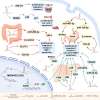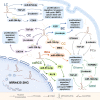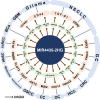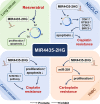MIR4435-2HG Is a Potential Pan-Cancer Biomarker for Diagnosis and Prognosis
- PMID: 35784328
- PMCID: PMC9240468
- DOI: 10.3389/fimmu.2022.855078
MIR4435-2HG Is a Potential Pan-Cancer Biomarker for Diagnosis and Prognosis
Abstract
The lncRNA MIR4435-2 host gene (MIR4435-2HG) is located on human chromosome 2q13, and its expression is up-regulated in 18 tumors. MIR4435-2HG participates in 6 signaling pathways to promote tumorigenesis, including the TGF-β signaling pathway, Wnt/β-catenin signaling pathway, MDM2/p53 signaling pathway, PI3K/AKT signaling pathway, Hippo signaling pathway, and MAPK/ERK signaling pathway. MIR4435-2HG competitively binds with 20 miRNAs to form a complex ceRNA network, thereby regulating the expression of downstream target genes. The high expression of MIR4435-2HG is also closely related to the clinicopathological characteristics and poor prognosis of a variety of tumors. Also, the high expression of MIR4435-2HG in peripheral blood or serum has the value of predicting the risk of 9 tumors. In addition, MIR4435-2HG participates in the mechanism of action of three cancer drugs, including resveratrol for the treatment of lung cancer, cisplatin for non-small cell lung cancer and colon cancer, and carboplatin for triple-negative breast cancer. This article systematically summarizes the diagnostic and prognostic value of MIR4435-2HG in a variety of tumors and outlines the ceRNA network and signaling pathways related to MIR4435-2HG, which will provide potential directions for future MIR4435-2HG research.
Keywords: MIR4435-2HG; cancer; competing endogenous RNA; diagnosis; prognosis.
Copyright © 2022 Zhong, Xie, Zeng, Yuan and Duan.
Conflict of interest statement
The authors declare that the research was conducted in the absence of any commercial or financial relationships that could be construed as a potential conflict of interest.
Figures







Similar articles
-
MIR4435-2HG: A novel biomarker for triple-negative breast cancer diagnosis and prognosis, activating cancer-associated fibroblasts and driving tumor invasion through EMT associated with JNK/c-Jun and p38 MAPK signaling pathway activation.Int Immunopharmacol. 2024 Dec 5;142(Pt B):113191. doi: 10.1016/j.intimp.2024.113191. Epub 2024 Sep 23. Int Immunopharmacol. 2024. PMID: 39317050
-
LncRNA MIR4435-2HG drives cancer progression by modulating cell cycle regulators and mTOR signaling in stroma-enriched subtypes of urothelial carcinoma of the bladder.Cell Oncol (Dordr). 2023 Oct;46(5):1509-1527. doi: 10.1007/s13402-023-00826-5. Epub 2023 Jun 24. Cell Oncol (Dordr). 2023. PMID: 37355516 Free PMC article.
-
LncRNA MIR4435-2HG-mediated upregulation of TGF-β1 promotes migration and proliferation of nonsmall cell lung cancer cells.Environ Toxicol. 2020 May;35(5):582-590. doi: 10.1002/tox.22893. Epub 2019 Dec 25. Environ Toxicol. 2020. PMID: 31875359
-
MIR4435-2HG: A newly proposed lncRNA in human cancer.Biomed Pharmacother. 2022 Jun;150:112971. doi: 10.1016/j.biopha.2022.112971. Epub 2022 Apr 18. Biomed Pharmacother. 2022. PMID: 35447550 Review.
-
MIR4435-2HG: A Tumor-associated Long Non-coding RNA.Curr Pharm Des. 2022;28(25):2043-2051. doi: 10.2174/1381612828666220607100228. Curr Pharm Des. 2022. PMID: 35674305 Review.
Cited by
-
A novel defined risk signature of cuproptosis-related long non-coding RNA for predicting prognosis, immune infiltration, and immunotherapy response in lung adenocarcinoma.Front Pharmacol. 2023 Aug 21;14:1146840. doi: 10.3389/fphar.2023.1146840. eCollection 2023. Front Pharmacol. 2023. PMID: 37670938 Free PMC article.
-
Applications and advances of multi-omics technologies in gastrointestinal tumors.Front Med (Lausanne). 2025 Jul 23;12:1630788. doi: 10.3389/fmed.2025.1630788. eCollection 2025. Front Med (Lausanne). 2025. PMID: 40771479 Free PMC article. Review.
-
Novel Insights into miR-944 in Cancer.Cancers (Basel). 2022 Aug 31;14(17):4232. doi: 10.3390/cancers14174232. Cancers (Basel). 2022. PMID: 36077769 Free PMC article. Review.
-
Prognostic significance of ING3 expression in patients with cancer: A systematic review and meta-analysis.Front Oncol. 2023 Feb 9;13:1090860. doi: 10.3389/fonc.2023.1090860. eCollection 2023. Front Oncol. 2023. PMID: 36845697 Free PMC article.
-
A non-negative spike-and-slab lasso generalized linear stacking prediction modeling method for high-dimensional omics data.BMC Bioinformatics. 2024 Mar 20;25(1):119. doi: 10.1186/s12859-024-05741-6. BMC Bioinformatics. 2024. PMID: 38509499 Free PMC article.
References
Publication types
MeSH terms
Substances
LinkOut - more resources
Full Text Sources
Medical
Research Materials
Miscellaneous

